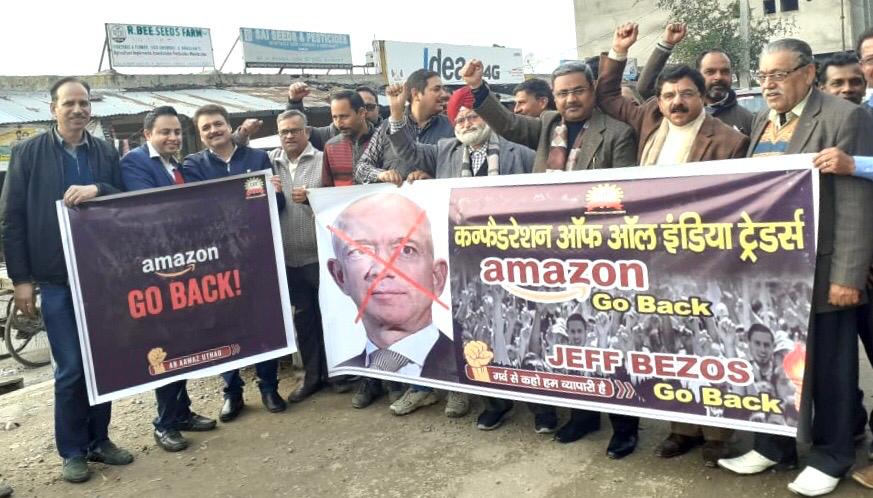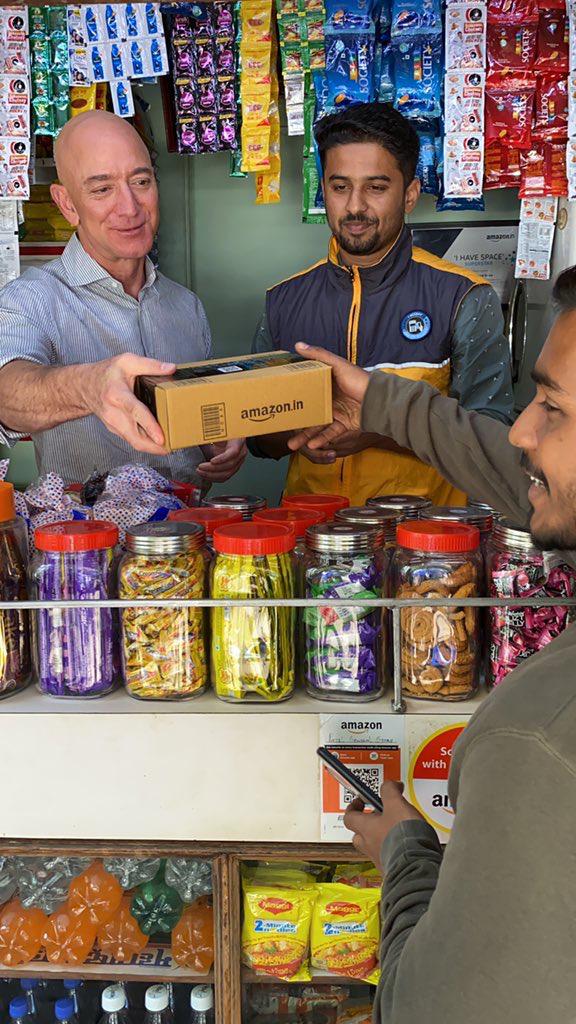On the outskirts of a north Indian city, Raju Gupta runs a wholesale shop of home decor selling products like designer wallpaper, artificial grass, and carpets. Having used Facebook for four years to generate online leads, he has been looking for a better alternative that can get more buyers through online means. When he heard that the Confederation of All Indian Traders (CAIT), a government association traders body, which he is a part of, is building a new e-commerce portal, he jumped on the bandwagon.
However, in the last couple of months, his efforts of getting the online shop up and running have not resulted in anything substantial. “The back-end is confusing, making it difficult to upload products. Plus, my customers are not able to find my shop as it often goes offline because of some bug,” Gupta told KrASIA.
In March this year, CAIT secretary general Praveen Khandelwal, who has been leading the protests against the two industry leaders—Amazon India and Walmart-backed Flipkart—announced that the industry body has started onboarding sellers on its new e-commerce portal Bharat-e-market to compete with the incumbents. The website is set to launch on August 15, India’s Independence Day.
“We chose this day to launch our website as it symbolizes our freedom from the clutches of these companies that are indulging in unhealthy and unethical business practices,” Khandelwal told KrASIA.
Read this: Arzooo levels the imbalance in India’s retail sector
After struggling for five years to stop e-commerce companies from providing deep discounts and preferential treatments to select sellers, CAIT realized it’s time to get its hands dirty and directly compete with the companies it is at odds with. With Bharat-e-market, CAIT is hoping it will be able to give Amazon and Flipkart stiff competition.
To begin with, it will launch around 30 categories, including fast-moving consumer goods, groceries, medicines, stationery, food, and gift items. To put things in perspective, Flipkart and Amazon India roughly list 50 categories each on their platforms.
CAIT has created a subsidiary that will own this e-commerce venture. Khandelwal claimed that by March next year, Bharat-e-market would have around 700,000 sellers. It is to be noted that after eight years of operations in India, Amazon has managed to get 850,000 sellers on its platform.
While onboarding 700,000 sellers in less than a year sounds like an overstatement, CAIT is luring more with zero commission charges to use its platform.
“Amazon and Flipkart charge anywhere between 5% and 35% depending on the product,” Khandelwal said. CAIT will come up with revenue models once it has a significant number of sellers and buyers on the platform.
The long-drawn battle
Over the last four years, CAIT, which represents 80 million sellers, has been waging a war against the two e-commerce giants on several fronts, including the dramatic burning of a life-sized effigy of Amazon CEO Jeff Bezos last year, taking both firms to court for allegedly killing competition, and putting pressure on the government to take action.
The first time the Indian government sought to rein in the thriving online marketplaces was in 2016, following the discount war that had been going on between Flipkart and Amazon since 2014.
Having landed a USD 1 billion check from marquee global VC funds, Flipkart kicked off Big Billion Days, a mega annual sales event, in October 2014. In response, Amazon brought The Great Indian Festival sales, and the two giants splurged money to fund heavy discounts—running as deep as 90%—to woo millions of Indian millennials. The result: thousands of small retailers of smartphones, electronic appliances, and apparel saw their sales waning as a chunk of their consumers shifted online.
In 2016, the government issued rules that prohibited online marketplaces from owning inventory, being overly dependent on one vendor for sales, and influencing prices. But the rules were not detailed enough, with no substantial changes happening afterward.
After much lobbying by offline trader associations in 2018, the government laid down the fine print of what e-marketplaces could and couldn’t do under the new FDI rules. Aside from prohibiting exclusive partnerships with vendors, the regulations in February 2019 said a seller wouldn’t be allowed on an online marketplace if the latter owns equity in the seller or controls over 25% of the sales of that seller.
Amazon and Flipkart have found a way around these rules. For instance, Amazon changed direct stakes in its preferred sellers Cloudtail and Appario into indirect ones.

In 2019, CAIT approached India’s anti-trust body Competition Commission of India (CCI) and the country’s commerce minister Piyush Goyal. The industry body was unhappy with the way online commerce companies had circumvented the laws and wanted CCI to probe the business practices of Amazon and Flipkart.
The complaint accused Amazon and Flipkart of promoting select sellers on their platforms and using deep discounts to kill the competition. However, both companies denied the charges and challenged the investigation in court due to a lack of evidence, halting the investigation for more than a year.
“When CCI began a probe last year, why did Amazon and Flipkart feel the need to challenge the investigation and go to court? “If you are complying with the rules, why stall the investigation?” asked Khandelwal.
Bharat-e-market, the new e-commerce venture by CAIT, stems from its unhappiness with the crawling pace of the legal system and the toothless laws floated by the government that didn’t do much for offline sellers.
Khandelwal believes online platforms should complement offline sales instead of competing. The Bharat-e-market platform works on an omnichannel model, giving users the freedom to purchase online once they have seen the product. Alternatively, they can also buy directly from the portal and later pick up the product from the shop they bought online. Khandelwal said Bharat-e-market will provide offline merchants with all the tools to help them sell online and compete with incumbents. According to him, the firm will partner with local delivery companies to ensure delivery within hours.
“These sellers have been neglected by dominant e-commerce companies that only promote products from a few select sellers, usually their own companies,” Khandelwal said, adding that he still has hopes for Flipkart and Amazon to shed unfair business practices and compete fairly in the market.
A source at one of the e-commerce firms told KrASIA that any multi-brand retail store would promote certain manufacturers whose products have more demand and better reviews from buyers. “If you walk into a Reliance Digital store, you will see products of Samsung, LG, and Philips displayed more prominently than lesser-known brands. Online marketplaces are doing the exact thing.”
While both e-commerce behemoths claim they have not indulged in any anti-competitive practices, CCI reopened the investigations last month. A week later, India laid down new consumer protection rules for online purchases. These rules bar e-marketplaces from promoting selected brands, holding flash sales, listing products of manufacturers it has stakes in, and putting private labels in the red. Other rules require marketplaces to provide product information such as manufacturing details, return and refund policies, as well as to appoint grievance redressal officers.

These rules might force Amazon and Flipkart to bid goodbye to their annual mega sales events, which contribute a significant chunk to their revenue. Since the consumer protection rules have not come into force yet, Amazon recently announced its marquee Prime Day sales in India from July 26–27. Other implications once these rules kick in include taking down product listings from some of their top sellers, in which they may have indirect stakes, and discontinuing private labels, on which they have spent millions of dollars over the last few years.
“All these private labels are made in India and goes with the ethos of the government that wants to promote locally made products. We don’t understand the reason behind blocking private labels,” the source quoted above said.
Moreover, the proposed amendments also hold e-commerce marketplaces liable for negligent conduct by sellers, filter products based on country of origin, and ask them to promote domestic goods.
Khandelwal believes these rules may rein in Amazon and Flipkart, which have allegedly deployed unethical business practices to stifle competition.
No one spared
It is to be noted that the e-commerce rules under the Consumer Protection Act are not only applicable to Amazon and Flipkart, but all the online commerce platforms, be it food ordering platforms like Swiggy and Zomato, or travel bookings websites like MakeMyTrip and Yatra.
While deep-pocketed Amazon and Flipkart vehemently oppose proposed amendments, the new regulations have made things far more difficult for smaller players, selling products through their own websites.
“The consumer protection rules are well-intended. But the way it’s written, it brings all the businesses that have an online presence and a delivery mechanism under its purview. It is unfair for smaller online businesses as they will also have to employ grievance officers,” the source said.
An industry veteran, who is part of one of the local trader groups, said these rules are meant to protect consumers, not traders. “Nobody is putting checks and balances on these companies, forget bringing new laws, even existing laws are not being implemented on these companies,” he said. Moreover, he argued that a small e-commerce firm could not comply with some of the rules. “We need a differentiation when these rules kick in,” the person said.
Furthermore, the new regulations don’t specifically talk about penalties for flouting the rules.
Read this: India’s e-commerce giant Flipkart shelves plan to enter food retail sector
“The government has been fooling CAIT for the last five years. Every time they take these issues up with the government, they get candy in return, and they are happy with it,” the second source quoted above said. FDI, as well as consumer protection rules, do not have any teeth to them that can punish the ones not complying with them.
Meanwhile, aside from the two e-commerce giants, other big players, including Tata Group, which is building an e-commerce empire, have raised concerns over clauses regarding related parties selling on the platforms and private labels. Since most players found the draft e-commerce rules “exhaustive and confusing,” the government has extended the timeline for stakeholders to submit comments and suggestions by two weeks to July 21.
Questions sent to Flipkart and Amazon India went unanswered at the time of publication.
As things stand, none of the stakeholders involved in the tussle seem to be happy. Amazon and Flipkart, along with all other e-commerce players, believe the new rules are taking things too far. On the other hand, sellers feel these rules are consumer-centric and don’t really benefit them. Consumers, on their part, stand to lose the choice of products as well as buying them at a discount once the flash sales and private labels are stopped. Meanwhile, the Indian government is being criticized by both sides. Offline trader group accuses the government of not taking any substantial steps against e-commerce majors, while online retailers, backed by foreign giants, condemn it for taking a nationalistic stance.
Amidst all this, small sellers are desperately looking for a route to bypass big e-commerce marketplaces. Many sellers now depend on Shopify to sell their products through their own online portals, said the industry veteran quoted above.
It may take some time before the current on-ground reality of millions of offline retailers changes. But once rolled out, CAIT’s new e-marketplace is likely to bring some relief to these retailers. However, unless Bharat-e-market can woo the customers the way Amazon, Flipkart, and other e-commerce companies have done, it is going to be an uphill battle for CAIT.






